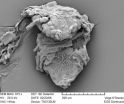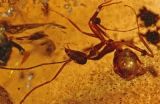(Press-News.org) Those who are proud to have a piece of amber that holds a little animal trapped in it maybe should not continue to read this. For what can be seen in the millions of years-old tree resin is almost always just a paper-thin façade. If sliced down the middle, you would find no more than a hollow space covered in some sort of "insect photo wallpaper."
This does not apply to the amber Bonn paleontologist Professor Dr. Jes Rust and his colleagues have been looking at for two years. The lumps that resemble herbal cough drops are "full of it," containing numerous insect bodies, some of which are extremely well preserved, despite the fact that they have been there for 50 million years. Better yet: The petrified resin is also very easily convinced to release its contents again. "The amber has not been completely polymerized, allowing it to be dissolved easily," explains Rust. They have so far found more than 700 arthropods from 55 different genera – mostly insects, but also spiders, mites, and plant parts.
The dirty brown lumps come from the coast of the NW India's Gujarat province. Their contents cast a new light on the history of the sub-continent, which is said to have "broken off" from the East African land mass 160 million years ago to float through the oceans in isolation – at the high speed of about 20 centimeters per year. And only about 50 million years ago, India collided with Asia in a crash that caused the land to fold up into the Himalayas.
If that were true, India would have been completely isolated for 100 million years. This time should have been sufficient to give rise to a unique flora and fauna. The Indian amber was formed 53 million years ago. So it shows, similar to an old photo, what life looked like in India just before the collision with the Asian continent. This snapshot should then primarily show animal species that do not exist elsewhere.
Island-hopping before the big crash
But just that is not the case: Similar insect fossils as in Gujarat have also been found in Europe and even in Central America. "This indicates that there was a lively exchange of species before our amber formed," Rust thinks. There may have been long chains of volcanic islands on the border between the continental plates – just like in Japan or Indonesia today. The insect species in India and Asia could have mingled by "island-hopping" – and also many million years before the big crash. And from Asia, they would then have spread further.
But the amber itself also raises questions. While it happens rather frequently that plants or animals get stuck in tree resin and end up covered by it, they usually decay over time. "In our amber, however, some resin component seems to have preserved the insects," says Rust.
In addition, the resin obviously comes from the family of Dipterocarpaceae, which today has its main range in the Indo-Malayan region. Until now it was thought that this type of plant had its heyday 25 million years ago. Jes Rust comments, "The Indian amber proves that extensive tropical forests of Dipterocarpaceae must already have existed there more than 50 million years ago. That is a big surprise."
INFORMATION:
Huge amber deposit discovered in India
The insects found inside the amber show that the sub-continent was by no means as isolated as was once assumed
2010-10-26
ELSE PRESS RELEASES FROM THIS DATE:
Anti-cholesterol drugs could help stave off seizures: UBC-Vancouver Coastal Health research
2010-10-26
Statins, the family of drugs used to lower cholesterol, might also reduce the risk of epileptic seizures in people with cardiovascular disease, according to a new statistical study by a drug safety expert at the University of British Columbia and Vancouver Coastal Health Research Institute. The findings could provide the basis for randomized, controlled clinical trials to test the efficacy of the drugs as anti-epileptic medication.
The study, based on a database of 2,400 Quebec residents aged 65 and older, showed that those taking statins were 35 per cent less likely ...
New trove of fossils suggests global distribution of tropical forest ecosystems in the Eocene
2010-10-26
Bees, termites, spiders, and flies entombed in a newly-excavated amber deposit are challenging the assumption that India was an isolated island-continent in the Early Eocene, or 52-50 million years ago. Arthropods found in the Cambay deposit from western India are not unique—as would be expected on an island—but rather have close evolutionary relationships with fossils from other continents. The amber is also the oldest evidence of a tropical broadleaf rainforest in Asia. The discovery is published this week in Proceedings of the National Academy of Sciences.
"We know ...
Decoding the disease that perplexes: Salk scientists discover new target for MS
2010-10-26
LA JOLLA, CA-Scientists are closer to solving one of the many mysteries of multiple sclerosis and other demyelinating diseases, thanks to a recent study conducted at the Salk Institute for Biological Studies. The research revealed a previously unknown connection between two ion channels, which, when misaligned, can cause the many bizarre symptoms that characterize the condition.
The findings, reported in this week's online edition of the Proceedings of the National Academy of Sciences (PNAS), provide fresh insights into the mechanisms underlying MS and suggest a novel ...
Heart disease prevention program saves lives and reduces costs, Kaiser Permanente study finds
2010-10-26
DENVER — A new study from Kaiser Permanente Colorado is one of the first to show that an intensive population management program that matches heart disease patients to personal nurses and clinical pharmacy specialists not only reduces the risk of death but reduces health care costs as well.
The findings are published in the November issue of the journal Pharmacotherapy.
Researchers examined health care expenditures in two populations of patients with heart disease: a group of 628 people enrolled in the Kaiser Permanente Collaborative Cardiac Care Service, a population ...
New fog warning system in Venice region pays for itself 10 times over
2010-10-26
Fog is a relatively frequent phenomenon in the Po Valley and constitutes a major issue for all road traffic. The new fog warning system covers and benefits the entire Venice Region, combining VTT`s know-how on intelligent transport and evaluation of information services. The system is expected to provide services for regular and professional motorists and transport companies as well as authorities. These types of warning solutions are expected to be in demand on a larger scale in the future as they have positive safety effects and are very profitable socio-economically. ...
Scientists reveal the sex wars of the truffle grounds
2010-10-26
They are one of the most highly prized delicacies in the culinary world, but now scientists have discovered that black truffles are locked in a gender war for reproduction. The research, published in New Phytologist as the truffle season begins, represents a breakthrough in the understanding of truffle cultivation and distribution.
The teams, led by Dr Francesco Paolocci and Dr Andrea Rubini from the CNR Plant Genetics Institute in Perugia and by Dr Francis Martin from INRA in Nancy, carried out their research on the reproduction strategy of the highly prized black ...
Sleep disturbances show clear association with work disability
2010-10-26
Sleep disturbances increase the risk of work disability and may slow the return to work process. This is especially true in cases where work disability is due to mental disorders or musculoskeletal diseases. These results come from a recent study conducted by the Finnish Institute of Occupational Health in collaboration with the universities of Turku and London.
The research is being conducted as part of two major research projects on social capital in the workplace (Kunta10) and on well-being in the hospital workplace. The follow-up study is part of the Academy of Finland ...
Allergies and wheezing illnesses in childhood may be determined in the womb
2010-10-26
A child's chances of developing allergies or wheezing is related to how he or she grew at vital stages in the womb, according to scientists from the University of Southampton.
The new research, funded by the Medical Research Council (MRC) and the British Lung Foundation, and undertaken at Southampton General Hospital, reveals that fetuses which develop quickly in early pregnancy but falter later in pregnancy are likely to go on to develop allergies and asthma as children. Scientists believe this is due to changes in the development of their immune system and lungs.
A ...
Research on avoiding fraud in biometric identification
2010-10-26
The field that these researchers are working in is known by its nickname, "anti-spoofing", and basically consists in trying to detect all of the possible attempts at fraud that a biometric system might suffer, especially with regard to an action in which the user presents the biometric proof to the system. "What we are trying to do is detect those attempts so that the system can then act accordingly", explains the head of UC3M's Grupo Universitario de Tecnologías de Identificación (GUTI)(University Identification Technology Group), Raúl Sánchez Reíllo, who is leading this ...
Beauty from the bottom up
2010-10-26
Flamingos apply natural make-up to their feathers to stand out and attract mates, according to a new study by Juan Amat, from the Estación Biológica de Doňana in Seville, Spain, and colleagues. Their research is the first to demonstrate that birds transfer the color pigments (carotenoids) from the secretions of their uropygial gland for cosmetic reasons. The uropygial or preen gland is found in the majority of birds and is situated near the base of the tail. The study is published online in Behavioral Ecology and Sociobiology, a Springer journal.
There is evidence ...
LAST 30 PRESS RELEASES:
Numbers in our sights affect how we perceive space
SIMJ announces global collaborative book project in commemoration of its 75th anniversary
Air pollution exposure and birth weight
Obstructive sleep apnea risk and mental health conditions among older adults
How talking slows eye movements behind the wheel
The Ceramic Society of Japan’s Oxoate Ceramics Research Association launches new international book project
Heart-brain connection: international study reveals the role of the vagus nerve in keeping the heart young
Researchers identify Rb1 as a predictive biomarker for a new therapeutic strategy in some breast cancers
Survey reveals ethical gaps slowing AI adoption in pediatric surgery
Stimulant ADHD medications work differently than thought
AI overestimates how smart people are, according to HSE economists
HSE researchers create genome-wide map of quadruplexes
Scientists boost cell "powerhouses" to burn more calories
Automatic label checking: The missing step in making reliable medical AI
Low daily alcohol intake linked to 50% heightened mouth cancer risk in India
American Meteorological Society announces Rick Spinrad as 2026 President-Elect
Biomass-based carbon capture spotlighted in newly released global climate webinar recording
Illuminating invisible nano pollutants: advanced bioimaging tracks the full journey of emerging nanoscale contaminants in living systems
How does age affect recovery from spinal cord injury?
Novel AI tool offers prognosis for patients with head and neck cancer
Fathers’ microplastic exposure tied to their children’s metabolic problems
Research validates laboratory model for studying high-grade serous ovarian cancer
SIR 2026 delivers transformative breakthroughs in minimally invasive medicine to improve patient care
Stem Cell Reports most downloaded papers of 2025 highlight the breadth and impact of stem cell research
Oxford-led study estimates NHS spends around 3% of its primary and secondary care budget on the health impacts of heat and cold in England
A researcher’s long quest leads to a smart composite breakthrough
Urban wild bees act as “microbial sensors” of city health.
New study finds where you live affects recovery after a hip fracture
Forecasting the impact of fully automated vehicle adoption on US road traffic injuries
Alcohol-related hospitalizations from 2016 to 2022
[Press-News.org] Huge amber deposit discovered in IndiaThe insects found inside the amber show that the sub-continent was by no means as isolated as was once assumed



